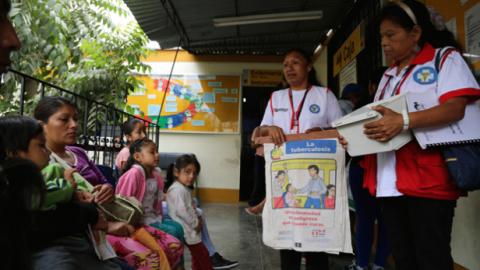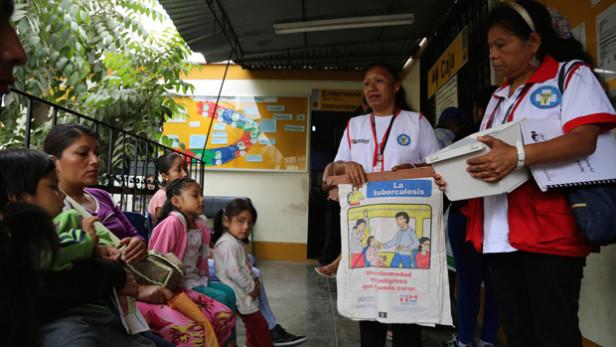
The theme for this year’s 45th Union World Conference for Lung Health, recently concluded in Barcelona, was “Community-driven solutions for the next generation.” Universal Health Coverage (UHC) emerged as a crucial complement to disease-specific interventions. The below excerpt of a Devex article by Sibylle Koenig explores the key role of UHC as discussed at the conference.
The recent Ebola outbreak has been a painful reminder for decision-makers that it’s impossible to build a healthy society without stabilizing one of its key foundations and pillars: health systems. Economic growth will not magically translate into better health access unless targeted action is taken to support health systems and ensure UHC.
This was underlined by South African Minister of Health Dr. Aaron Motsoaledi.
“Development partners must know that one of the best ways to achieve the goals of the world in eradicating disease is to strengthen health systems,” Motsoaledi told Devex. “This is a call to everybody — not only donors, but also to African countries themselves — to invest in health systems strengthening. You cannot focus development away from health — it is impossible.”
If this is clear, what keeps us from doing it? According to Denis Porignon, a health policy expert at the World Health Organization, health financing and delivering good quality services have been — and continue to be — the most important challenges to address in that context.
“Fortunately, there is an increasing number of partners who are keen to support activities and reforms at country level,” Porignon told Devex. “The share of domestic funding for health has increased significantly in many African countries — including fragile ones such as Chad — in recent years and so has donor money, albeit it still being very disease-focused.”
A positive example of an innovative partnership for universal health access is the European Union-WHO-Luxembourg UHC Partnership, launched in 2011 with the goal of supporting policy dialogue on national health policies, strategies and plans as well as UHC in 19 selected countries.
Since its inception, the program attracted not only additional support from EU member states, bringing the total program budget to 37 million euros ($46.26 million), but also garnered interest among non-participating developing countries such as Tajikistan and Bolivia, which are “knocking on the door to at least become part of the network and thinking process,” Porignon said.
At country level, the program is implemented on the basis of country-tailored roadmaps, elaborated in close collaboration with beneficiary country governments, civil society and the private sector. Implementation is facilitated through the placement of full-time WHO technical assistants within the health ministries of most beneficiary countries.
“As the EU and Luxembourg support to this phase of the partnership is currently scheduled to end in December 2015, it is very important for us to assess and demonstrate what has been achieved to date with regard to UHC so that we can hope for continued funding in 2016 and beyond,” noted Porignon.
But how can a program of such magnitude keep track of its results in 19 different countries? One tool successfully tested is the organization of joint annual reviews involving government and WHO representatives from all beneficiary countries, allowing for peer review between countries. The latest review revealed that all involved governments positively evaluated the program’s contribution to HSS in their respective countries.
“While it is — admittedly — difficult to establish a direct link between this work and reduced mortality and morbidity in the beneficiary countries, the program contributes to ensuring the adequate and most effective allocation of national resources, in order to make the overall action of beneficiary country governments respond better to the expectations of their populations,” Porignon explained. The WHO expert pointed out the program is also promoting community participation.
“What [we] did in Tunisia, for example, was to support the process of consulting the public and civil society on the health system reform,” Porignon said. Public opinion surveys were organized and views were synthesized in a “white book” handed over to Tunisia’s prime minister at the country’s first national health conference in September 2013. “During the event, the prime minister seized the ball,” praising the initiative as “exemplary for the innovative practice of democracy and encouraging other ministries to replicate the exercise within their sectors.”
But what about the UHC partnership’s sustainability once donor funding comes to an end?
With Luxembourg’s financial support, specific funding has been set aside for the elaboration of training modules on strategic policy setting and planning, Porignon explained, with training of ministry of health personnel set to start in 2015. One key challenge is the high turnover affecting many partner countries’ ministries of health, meaning that training will need to be continuous.
“If we have a few more years in the program, there will be time to monitor and evaluate activities in a way to effectively contribute to capacity building of engaged stakeholders,” the WHO expert said.
The UHC partnership echoes WHO’s key objectives for 2014 to 2018 and its main message to the international aid community, namely to “help the ministries of health in partner countries to build a vision and a plan about what they want to do and align to that plan.”
